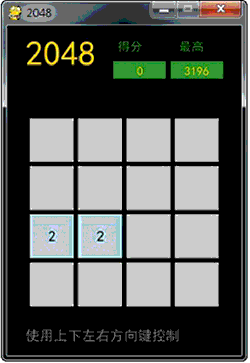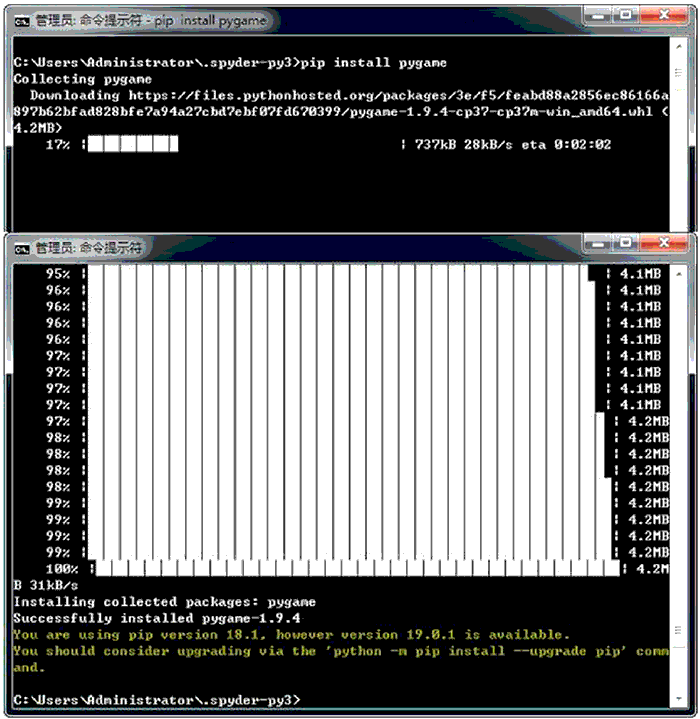Python实例:小游戏20148
本节教程通过 2048 的小游戏快速、完整地呈现了使用 Python 语言编程的过程,将之前介绍的内容有机地结合在了一起 。2048是一款流行于手机、平板等终端设备上的益智小游戏,最早于 2014 年 3 月发行,主界面如图 1 所示。

图 1:2048 小游戏的主界面
其游戏规则是:每次可以选择上下左右其中一个方向去滑动,每滑动一次,所有的数字方块都会往滑动的方向靠拢,系统也会在空白的地方随机出现一个数字方块,相同数字的方块在靠拢、相撞时会相加。系统给予的数字方块不是 2 就是 4,玩家要想办法在这小小的 16 格范围中凑出“2048”这个数字方块。
网友总结的游戏技巧有:

图 2:2048 小游戏的主要流程
根据流程图,可以将整个游戏程序大致分为三个部分:
其中第三部分可以继续细分为以下三个部分:
为了游戏界面效果美观,这里使用了 pygame 库。安装 pygame 库的命令如下:
安装过程如图 3 所示。

图 3:pygame 库安装过程
下面我们继续关注 2048 小游戏。首先来看程序初始化,这里主要完成以下工作:导入所需模块,初始化棋盘和窗口界面,初始化各种组件和变量。根据游戏规则,棋盘大小为 4×4 共 16 格的正方形棋盘,简便起见我们使用二维列表存储每个格子里的数字。
定义棋盘并初始化每个格子存储的数字的语句如下:
以下语句用于初始化窗口的相关属性:
绘制棋盘格子主要由 Box 类和 draw_box( ) 函数完成:
接下来需要初始化棋盘上开局的数字,来看 set_random_number( ) 函数:
以下代码将绘制游戏窗口其余的界面内容:
判断用户操作并处理是通过无限循环完成的,代码如下:
为了实现游戏效果,还有几个关键函数需要定义:一是对棋盘上的数字求和,用于当用户按下上下左右操作键后合并棋盘上的数字,代码如下:
二是用户按下上下左右控制键后对应的操作,需要注意的是,我们定义存放棋盘上数字的列表是行式二维列表,故处理左右键相对容易,只需对左右相邻的数字判断是否应该合并即可,而处理上下键时则需要按照对应的列找到目标数字,再判断是否应该合并。代码如下:
三是判断游戏是否结束的函数 is_over( )。按照游戏规则,当棋盘上仍然存在空格,或是同一行/列存在相邻且相同的数字时,游戏方可继续进行,否则游戏结束,该函数可做如下定义:
至此,小游戏 2048 的主要内容和关键代码介绍完毕。

图 1:2048 小游戏的主界面
其游戏规则是:每次可以选择上下左右其中一个方向去滑动,每滑动一次,所有的数字方块都会往滑动的方向靠拢,系统也会在空白的地方随机出现一个数字方块,相同数字的方块在靠拢、相撞时会相加。系统给予的数字方块不是 2 就是 4,玩家要想办法在这小小的 16 格范围中凑出“2048”这个数字方块。
网友总结的游戏技巧有:
- 最大数尽可能放在角落;
- 数字按顺序紧邻排列;
- 首先满足最大数和次大数在的那一列/行是满的;
- 时刻注意活动较大数(32以上)旁边要有相近的数;
- 以大数所在的一行为主要移动方向;
- 不要急于“清理桌面”;
- 根据游戏规则,可以整理出游戏的流程,如图 2 所示。

图 2:2048 小游戏的主要流程
根据流程图,可以将整个游戏程序大致分为三个部分:
- 程序初始化;
- 判断用户输入;
- 进入游戏主循环。
其中第三部分可以继续细分为以下三个部分:
- 等待操作;
- 判断操作并处理;
- 重新开始或退出。
为了游戏界面效果美观,这里使用了 pygame 库。安装 pygame 库的命令如下:
pip install pygame
安装过程如图 3 所示。

图 3:pygame 库安装过程
下面我们继续关注 2048 小游戏。首先来看程序初始化,这里主要完成以下工作:导入所需模块,初始化棋盘和窗口界面,初始化各种组件和变量。根据游戏规则,棋盘大小为 4×4 共 16 格的正方形棋盘,简便起见我们使用二维列表存储每个格子里的数字。
定义棋盘并初始化每个格子存储的数字的语句如下:
board = [[0, 0, 0, 0]
[0, 0, 0, 0],
[0, 0, 0, 0],
[0, 0, 0, 0]]
以下语句用于初始化窗口的相关属性:
#每个格子的边长,单位:像素(下同)
box_size = 50
#格子之间的间距
box_gap = 5
#中心棋盘区域上边缘离窗口顶部的距离
top_of_window = 100
#中心棋盘区域下边缘离窗口底部的距离
bottom_of_window = 30
#中心棋盘区域左边缘离窗口左边的距离
left_of_window = 2 0
#窗口宽度
window_width = box_size * 4 + box_gap * 5 + left_of_window * 2
#窗口高度
window_height = top_of_window + box_gap * 5 + box_size * 4 + left_of_window + bottom_of_window
#初始化窗口
window = pygame.display.set_mode((window_width, window_height), 0, 32)
#窗口标题
pygame.display.set_caption("2048")
#得分
score = 0
#使用 pygame 内置颜色值定义一些颜色常量
OLDLACE = pygame.color.THECOLORS["oldlacen"]
IVORY = pygame.color.THECOLORS["ivory3"]
BLACK = pygame.color.THECOLORS["black"]
RED = pygame.color.THECOLORS["red"]
RED2 = pygame.color.THECOLORS["red2"]
DARKGOLD = pygame.color.THECOLORS["darkgoldenrodl"]
GOLD = pygame.color.THECOLORS["gold"]
GRAY = pygame.color.THECOLORS["gray41"]
CHOCOLATE = pygame.color.THECOLORS["chocolate"]
CHOCOLATE1 = pygame.color.THECOLORS["chocolate1"]
CORAL = pygame.color.THECOLORS["coral"]
CORAL2 = pygame.color.THECOLORS["coral2"]
ORANGED = pygame.color.THECOLORS["orangered"]
ORANGED2 = pygame.color.THECOLORS["orangered2"]
DARKORANGE = pygame.color.THECOLORS["darkorange"]
DARKORANGE2 = pygame.color.THECOLORS["darkorange2"]
FORESTGREEN = pygame.color.THECOLORS["forestgreen"]
#界面字体
FONTNAME = "SimHei"
绘制棋盘格子主要由 Box 类和 draw_box( ) 函数完成:
class Box:
def __init__(self, topleft, text, color):
self.topleft = topleft
self.text = text
self.color = color
def render(self, surface):
x, y = self.topleft
#绘制棋盘格
pygame.draw.rect(surface, self.color, (xz y, box_size, box_ size))
#定义棋盘格中数字的高度
text_height = int(box_size * 0.35)
#设置棋盘格中数字使用的字体
font_obj = pygame.font.SysFont(FONTNAME, text_height)
text_surface = font_obj.render(self.text, True, BLACK)
text_rect = text_surface.get_rect()
text_rect.center = (x + box_size / 2, y + box_size / 2)
surface.blit(text_surface, text_rect)
def draw_box():
giobal board
#定义棋盘上每个格子中不同数字的颜色
colors = {0 : (192, 192, 192) , 2 : (176, 224, 230) , 4 : (127, 255, 212), 8 : (135, 206, 235) , 16 : (64, 224, 208),
32 : (0, 255, 255), 64 : (0, 201, 87), 128: (50, 205, 50), 256 : (34, 139, 34),
512 : (0, 255, 127) , 1024 : (61, 145, 64), 2048 : (48, 128, 20), 4096 : (65, 105, 255),
8192 : (8, 46, 84) , 16384 : (11, 23, 70), 32 768: (25, 25, 112), 65536 : (0, 0, 255) }
x, y = left_of_window, top_of_window
size = box_size * 4 + box gap * 5
pygame.draw.rect(window, BLACK, (x, y, size, size))
x, y = x + box_gap, y + box_gap
#使用嵌套循环绘制棋盘上所有格子
for i in range(4):
for j in range(4):
idx = board. [ i ] [ j ]
if idx == 0:
text =""
else :
text = str(idx)
if idx > 65536: idx = 65536
color = colors[idx]
box = Box((x, y), text, color) box.render(window)
x += box_size + box_gap
x = left_of_window + box_gap
y += box_size + box_gap
接下来需要初始化棋盘上开局的数字,来看 set_random_number( ) 函数:
def set_random_number():
pool =[]
for i in range(4):
for j in range (4):
if board[i][j] == 0:
pool. append. ( (if j ))
m = random.choice(pool)
pool.remove(m)
value = random.uniform(0, 1)
if value < 0.1:
value = 4
else :
value = 2
board[m[0]][m[1]] = value
其作用是在棋盘上随机选取两个格子,将其值设置为 2 或 4。以下代码将绘制游戏窗口其余的界面内容:
#显示游戏名称
window.blit(write ("2048", height = 45, color = GOLD), (left_of_ window, left_of_window // 2))
#显示当前得分
window.blit(write("得分", height=14, color=FORESTGREEN), (left_of_window+105, left_of_window//2 + 5))
rect1 = pygame.draw.rect(window, FORESTGREEN, (left_of_window+100, left_of_window//2 + 30, 60, 20))
text1 = write(str(score), height=14, color=GOLD)
text1_rect = text1.get_rect()
text1_rect.center = (left_of_window+100+30, left_of_window//2 + 40)
window.blit(textlf textl_rect)
#显示历史最高分
window.blit(write("最高", height=14, color=FORESTGREEN), (left_of_window+175, left_of_window//2 + 5))
rect2 = pygame.draw.rect(window, FORESTGREEN, (left_of_window+165, left_of_window//2 + 30, 60, 20))
#读取历史最高分
best = read_best()
if best < score:
best = score
text2 = write(str(best), height=14, color=GOLD)
text2_rect = text2.get_rect()
text2_rect.center = (left_of_window+165+30, left_of_window//2 + 40)
window.blit(text2, text2_rect)
#显示游戏操作提示
window.blit(write("使用上下左右方向键控制", height=16, color=GRAY), (left_of_window, window_height - bottom_of_Window))
判断用户操作并处理是通过无限循环完成的,代码如下:
while True:
#通过事件机制获取当前用户操作
for event in pygame.event.get():
#用户操作为退出窗口或按下ESC键时写入最高分,并退出游戏窗口
if event.type == QUIT or (event.type == KEYUP and event.key == K_ESCAPE):
write_best(best)
pygame.quit ()
exit ()
#游戏没有正常结束时监听用户的操作
elif not gameover:
#用户按下键盘上的向上方向键
if event.type == KEYUP and event.key == K_UP:
up()
#用户按下键盘上的向下方向键
elif event.type ==KEYUP and event.key == K DOWN:
down()
#用户按下键盘上的向左方向键
elif event.type ==KEYUP and event.key == K_LEFT:
left ()
# 用户按下键盘上的向右方向键
elif event.type ==KEYUP and event.key == K_ RHGHT:
right ()
#开始新游戏
if newboard != board:
set_random_number()
newboard = deepcopy(board) draw_box()
gameover = is_over()
rect1 = pygame.draw.rect(window, FORESTGREEN,(left_ of_window+100, left_of_window//2 + 30, 60, 20))
text1 = write(str(score), height=14, color=GOLD)
text_rect = text1.get_rect()
text_rect.center = (left_of_window+100+30Aleft_of_window//2 + 4 0)
window.blit(text1, text_rect)
rect2 = pygame.draw.rect(window, FORESTGREEN, (left_of_window+165, left_of_window//2 + 30, 60, 20))
if best < score:
best = score
text2 = write(str(best), height=14, color=GOLD)
text2_rect = text2.get_rect()
text2_rect.center = (left_of_window+l65+30, left_of_window//2 + 4 0)
window.blit(text2, text2_rect)
#游戏正常结束(即用户合成了 2048或未合成2048但棋盘上已经无法继续下一步操作)
else :
write_best(best)
window.blit(write("游戏结束! ", height = 40, color = FORESTGREEN), (left_of_windowz window_height // 2))
为了实现游戏效果,还有几个关键函数需要定义:一是对棋盘上的数字求和,用于当用户按下上下左右操作键后合并棋盘上的数字,代码如下:
def combinate(L):
glbal score
ans = [0, 0, 0 , 0]
num =[]
for i in L:
if i != 0:
num. append. (i)
length = len(num)
#当不为0的数字有4个时
if length == 4:
if num[0] == num[1]:
ans[0] = num[0] + num[1]
score += ans[0]
if num[2] == num[3]:
ans[1] = num[2] + num [3]
score += ans[1]
else :
ans[1]=num[2]
ans [2]=num[3]
elif num[1] ==num[2]
ans [0]= num[0]
ans[1]= num[1] + num[2]
ans [2]= num[3]
score += ans[1]
elif num[2] ==num[3]
ans [ 0]= num[0]
ans[1]= num[1]
ans [2]= num[2] + num[3]
score += ans[2]
else :
for i in range(length):
ans[i] = num[i]
#当不为0的数字有3个时
elif length == 3:
if num[0] == num[1]:
ans[0] = num[0] + num[1]
ans[1] = num[2]
score += ans[0]
elif num[1] == num[2]:
ans [0] = num[0]
ans[1]=num[1] + num[2]
score += ans[1]
else :
for i in range(length):
ans[i] = num[i]
#当不为0的数字有2个时
elif length == 2:
if num[0] == num[1]:
ans[0] = num[0] + num[1]
score += ans[0]
else :
for i in range(length):
ans[i] = num[i]
#当不为0的数字只有1个时
elif length == 1:
ans[0] = num[0]
else :
pass
return ans
二是用户按下上下左右控制键后对应的操作,需要注意的是,我们定义存放棋盘上数字的列表是行式二维列表,故处理左右键相对容易,只需对左右相邻的数字判断是否应该合并即可,而处理上下键时则需要按照对应的列找到目标数字,再判断是否应该合并。代码如下:
def left():
for i in range(4):
temp = combinate (boa:rd [ i ])
for j in range (4):
board[i][j] = temp[j]
def right():
for i in range(4):
temp = combinate (boaird[i][::-1]
for j in range (4):
board[i][3-j] = temp[j]
def up():
for i in range(4):
to_comb =[]
for j in range (4):
to_comb.append(board[j][i])
temp = combinate(to_comb)
for k in range(4):
board[k][i] = temp[k]
def down():
for i in range(4):
to_comb =[]
for j in range (4):
to_comb.append(board[3-j][i])
temp = combina.te(to_comb)
for k in range (4):
board[3-k][i] = temp[k]
三是判断游戏是否结束的函数 is_over( )。按照游戏规则,当棋盘上仍然存在空格,或是同一行/列存在相邻且相同的数字时,游戏方可继续进行,否则游戏结束,该函数可做如下定义:
def is_over():
#棋盘上仍然存在空格
for i in range(4):
for j in range(4):
if board[i][j]==0:
return False
#同一行中存在相邻且相同的数字
for i in range(4):
for j in range(3):
if board[i][j] == board[i][j+1]:
return False
#同一列中存在相邻且相同的数字
for i in range(3):
for j in range(4):
if board[i][j] == board[i+1][j]:
return False
return True
至此,小游戏 2048 的主要内容和关键代码介绍完毕。
所有教程
- C语言入门
- C语言编译器
- C语言项目案例
- 数据结构
- C++
- STL
- C++11
- socket
- GCC
- GDB
- Makefile
- OpenCV
- Qt教程
- Unity 3D
- UE4
- 游戏引擎
- Python
- Python并发编程
- TensorFlow
- Django
- NumPy
- Linux
- Shell
- Java教程
- 设计模式
- Java Swing
- Servlet
- JSP教程
- Struts2
- Maven
- Spring
- Spring MVC
- Spring Boot
- Spring Cloud
- Hibernate
- Mybatis
- MySQL教程
- MySQL函数
- NoSQL
- Redis
- MongoDB
- HBase
- Go语言
- C#
- MATLAB
- JavaScript
- Bootstrap
- HTML
- CSS教程
- PHP
- 汇编语言
- TCP/IP
- vi命令
- Android教程
- 区块链
- Docker
- 大数据
- 云计算